英语四上Unit2第二课时教案
- 格式:doc
- 大小:39.50 KB
- 文档页数:3
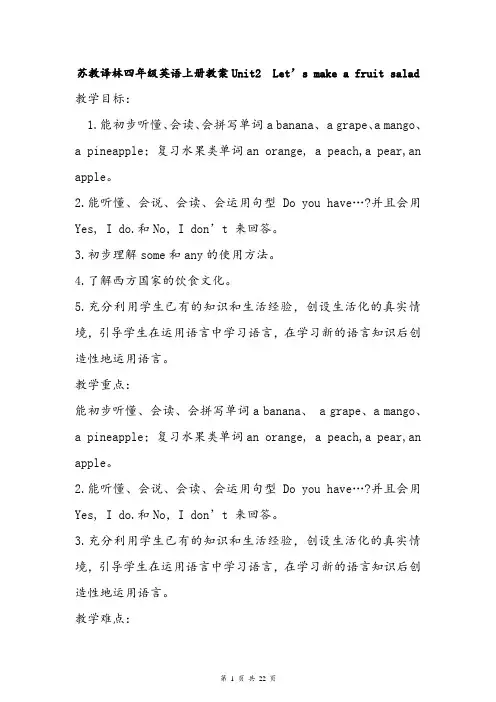
苏教译林四年级英语上册教案Unit2 Let’s make a fruit salad 教学目标:1.能初步听懂、会读、会拼写单词a banana、 a grape、a mango、a pineapple;复习水果类单词an orange, a peach,a pear,an apple。
2.能听懂、会说、会读、会运用句型Do you have…?并且会用Yes, I do.和No,I don’t 来回答。
3.初步理解some和any的使用方法。
4.了解西方国家的饮食文化。
5.充分利用学生已有的知识和生活经验,创设生活化的真实情境,引导学生在运用语言中学习语言,在学习新的语言知识后创造性地运用语言。
教学重点:能初步听懂、会读、会拼写单词a banana、 a grape、a mango、a pineapple;复习水果类单词an orange, a peach,a pear,an apple。
2.能听懂、会说、会读、会运用句型Do you have…?并且会用Yes, I do.和No,I don’t 来回答。
3.充分利用学生已有的知识和生活经验,创设生活化的真实情境,引导学生在运用语言中学习语言,在学习新的语言知识后创造性地运用语言。
教学难点:1. 初步理解some和any的使用方法。
教学疑点学生能否理解some和any的使用方法,渗透的语法知识能否完全掌握?教学准备:挂图,卡片,多媒体(PPT),学生自带水果,老师做的水果沙拉教学过程:Step 1 Greeting and warm up1.GreetingT: Hello, boys and girls. How are you ?S: I’m fine, thank you. And you?T: I’m well.2.Warm upPlay a game----Fast response游戏规则:快速闪现问题,抢答例如:What can you see?I like monkeys, What do you like ?Do you like monkeys ?What colour is the …?Step 2 Presentation1.Play a game----Magic bag游戏规则:收口的口袋里装些玩具和水果。
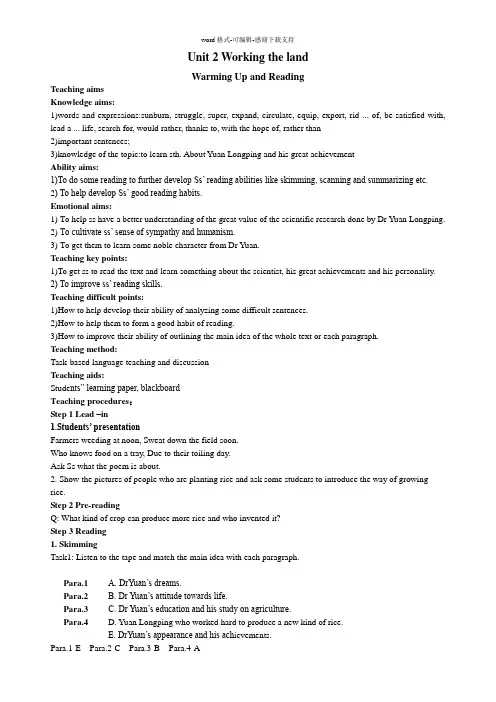
Unit 2 Working the landWarming Up and ReadingTeaching aimsKnowledge aims:1)words and expressions:sunburn, struggle, super, expand, circulate, equip, export, rid ... of, be satisfied with, lead a ... life, search for, would rather, thanks to, with the hope of, rather than2)important sentences;3)knowledge of the topic:to learn sth. About Yuan Longping and his great achievementAbility aims:1)To do some reading to further develop Ss’ reading abilities like skimming, scanning and summarizing etc.2) To help develop Ss’ good reading habits.Emotional aims:1)To help ss have a better understanding of the great value of the scientific research done by Dr Yuan Longping.2)To cultivate ss’ sense of sympathy and humanism.3)To get them to learn some noble character from Dr Y uan.Teaching key points:1)To get ss to read the text and learn something about the scientist, his great achievements and his personality.2) To improve ss’ reading skills.Teaching difficult points:1)How to help develop their ability of analyzing some difficult sentences.2)How to help them to form a good habit of reading.3)How to improve their ability of outlining the main idea of the whole text or each paragraph.Teaching method:Task-based language teaching and discussionTeaching aids:Stude nts” learning paper, blackboardTeaching procedures:Step 1 Lead –in1.Students’ presentationFarmers weeding at noon, Sweat down the field soon.Who knows food on a tray, Due to their toiling day.Ask Ss what the poem is about.2. Show the pictures of people who are planting rice and ask some students to introduce the way of growing rice.Step 2 Pre-readingQ: What kind of crop can produce more rice and who invented it?Step 3 Reading1. SkimmingTask1: Listen to the tape and match the main idea with each paragraph.Para.1 A. DrYuan’s dreams.Para.2 B. Dr Yuan’s attitude towards life.Para.3 C. Dr Yuan’s education and his study on agriculture.Para.4 D. Yuan Longping who worked hard to produce a new kind of rice.E. DrYuan’s appearance and his ach ievements.Para.1-E Para.2-C Para.3-B Para.4-A2. ScanningTask2: Choose the best answer to each question according to the text.(1). According to the text, in 1950, Chinese farmers could produce about __C___ million tons of rice.A. 26B.260C.56D.560(2). What does the word “battle” refer to in Para.2 ? BA. The low rice output.B. Ridding the world of hunger.C. Fighting against farming.D. The freedom to do research(3). It can be inferred (推断) from the text that C .A. Yuan cares about money and being famous.B. Yuan is interested in playing the piano.C. Yuan’s rice is grown in many countries.D. Spending money on himself means very little to Dr Y uan.3.Careful readingStep4 Summary (using about 30 words)The passage tells us that the great achievements Yuan Longping made in his research on hybrid rice , his noble personalities and his dreams.Step 5 Homework1. According to the resume, write a passage about Yuan Longping using 5 sentences.2.Fill in the blankYuan Longping is one of China’s most famous 1 (science).Born in 1930, DrYuan graduated 2 Southwest Agricultural College in 1953.At that time, hunger was 3 disturbing problem in many parts of the countryside. Since then, 4 (find) ways to grow more rice has been his life goal. In 1974, he invented Super hybrid rice and 5 (become)the first 6 (agriculture) pioneer in the world.Thanks to 7 research, the UN has more tools in the battle to rid the world 8 hunger. Dr Yuan is now circulating his knowledge in many less developed countries.Keys: 1.scientists 2. from 3.a 4. finding 5. became 6. agricultural 7. his 8. ofImportant language pointsStep1 Revision1.Check the homework exercises.2.Ask some Ss to talk about Dr Longping and his super hybrid rice.Step2 Studying important language points1.Although he is one of China’s most famous scientists, Yuan Longping considers himself a farmer,for he works the land to do his research.这是一个并列复合句。
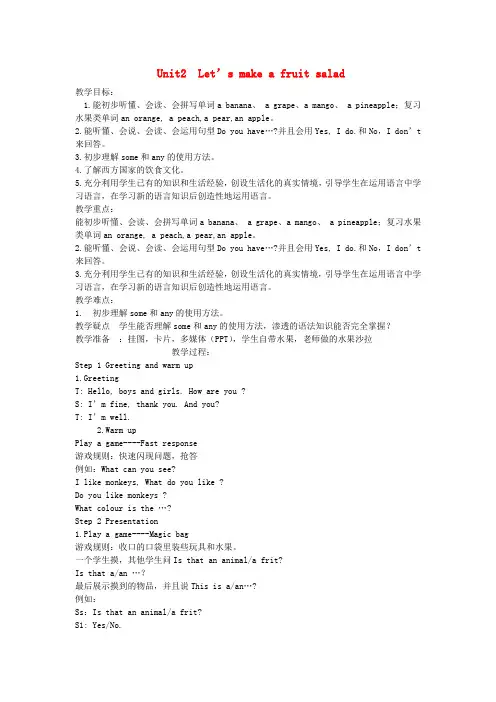
Unit2 Let’s make a fruit salad教学目标:1.能初步听懂、会读、会拼写单词a banana、 a grape、a mango、 a pineapple;复习水果类单词an orange, a peach,a pear,an apple。
2.能听懂、会说、会读、会运用句型Do you have…?并且会用Yes, I do.和No,I don’t 来回答。
3.初步理解some和any的使用方法。
4.了解西方国家的饮食文化。
5.充分利用学生已有的知识和生活经验,创设生活化的真实情境,引导学生在运用语言中学习语言,在学习新的语言知识后创造性地运用语言。
教学重点:能初步听懂、会读、会拼写单词a banana、 a grape、a mango、 a pineapple;复习水果类单词an orange, a peach,a pear,an apple。
2.能听懂、会说、会读、会运用句型Do you have…?并且会用Yes, I do.和No,I don’t 来回答。
3.充分利用学生已有的知识和生活经验,创设生活化的真实情境,引导学生在运用语言中学习语言,在学习新的语言知识后创造性地运用语言。
教学难点:1. 初步理解some和any的使用方法。
教学疑点学生能否理解some和any的使用方法,渗透的语法知识能否完全掌握?教学准备:挂图,卡片,多媒体(PPT),学生自带水果,老师做的水果沙拉教学过程:Step 1 Greeting and warm up1.GreetingT: Hello, boys and girls. How are you ?S: I’m fine, thank you. And you?T: I’m well.2.Warm upPlay a game----Fast response游戏规则:快速闪现问题,抢答例如:What can you see?I like monkeys, What do you like ?Do you like monkeys ?What colour is the …?Step 2 Presentation1.Play a game----Magic bag游戏规则:收口的口袋里装些玩具和水果。
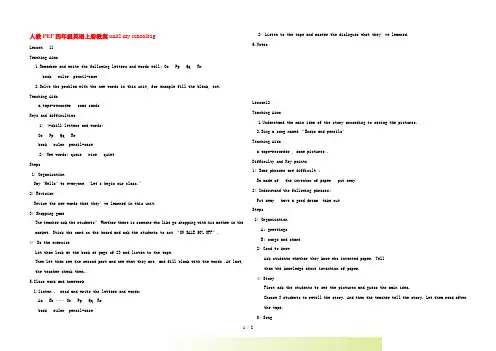
人教PEP四年级英语上册教案unit2 my schoolbagLesson 11Teaching Aims1.Remember and write the following letters and words well: Oo Pp Qq Rrbook ruler pencil-case2.Solve the problem with the new words in this unit, for example fill the blank, ect.Teaching Aidsa tape-recorder some cardsKeys and difficulties1)4-skill letters and words:Oo Pp Qq Rrbook ruler pencil-case2)New words: queue rice quietSteps1) OrganizationSay "Hello" to everyone, "Let's begin our class."2) RevisionRevise the new words that they’ve learned in this unit.3) Shopping gameThe teacher ask the students” Whether there is someone who like go shopping with his mother in the market. Stick the card on the board and ask the students to act “ON SALE 50% OFF”.4)Do the exerciseLet them look at the book at page of 23 and listen to the tape.Then let them see the second part and see what they are, and fill blank with the words .At last, the teacher check them..5.Class work and homework1)listen 、 read and write the letters and words:Aa Bb …… Oo Pp Qq Rrbook ruler pencil-case2) Listen to the tape and master the dialogues what they’ve learned.6.NotesLesson12Teaching Aims1.Understand the main idea of the story according to seeing the pictures.2.Sing a song named “Books and pencils”Teaching Aidsa tape-recorder , some pictures .Difficulty and Key points1) Some phrases are difficult :Be made of the inventor of paper put away2) Understand the following phrases:Put away have a good dream take outSteps1) OrganizationA: greetingsB: songs and chant2) Good to knowAsk students whether they know who invented paper. Tellthem the knowledge about invention of paper.4) StoryFirst ask the students to see the pictures and guess the main idea.Choose 3 students to retell the story. And then the teacher tell the story. Let them read after the tape.5) SongA: read the sentences of the song.B: Listen to the tape and learn to sing the song.C: sing the song with clapping hands 3 times.5. Homework1 ) Revise the dialogues of this unit.2 ) Sing the songs.1.Teaching notes。
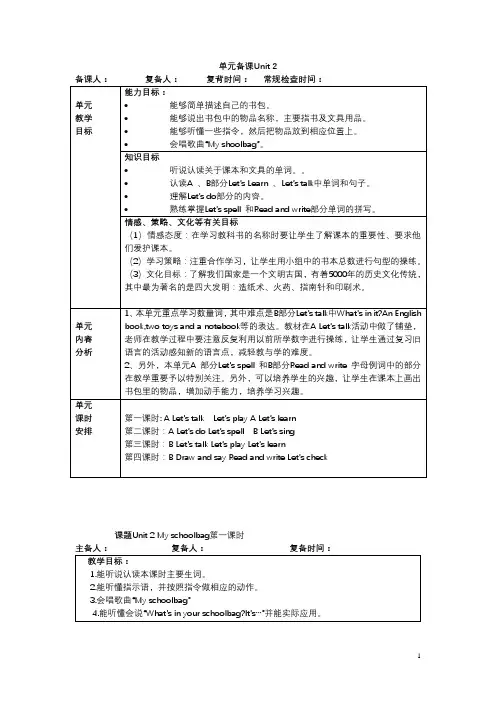
教法与教具准备:1.准备好各学科的书本。
2.教材相配套的教学录音带。
3.教材相配套的教学课件。
4.准备本节课需要的单词卡片与i的音标卡片。
教与学的活动:修改补充内容(一)热身、复习(Warm-up/Revision)1.复习单词。
注:要求听说的单词,让学生看图说单词。
2. 复习句子。
Pair work 与group work均可采用。
加强学生之间的合作与竞争。
3. 复习第一单元中表示方位的几个介词,加以练习。
(二)呈现新课(Presentation)1. 听let’s do 部分的录音,准备好手里的课本,能够通过录音对let’s do作出判断。
2. 要观察在过程中有没有拿对正确的课本,并且能够放在正确的位置。
3. Let’s spell 主要分为3个环节,一是read listen and chant,这部分要求学生听录音初步感知chant中的单词的读音和发音,并能跟随录音唱出其中的句子和单词,See the nice new kite,with the big numbernine.Do you like the new kite?Yes,it is very fine.2. 听力小达人。
Listen and number,不仅考察学生对数字的掌握,也需要学生对单词的发音要熟悉。
对i的发音区别有进一步感知与了解。
3. 出示i的音标卡片,[ai] 和[i]。
教授两个音标的读音。
4. 为了使教学效果更加突出,使音标更加具体化和形象化,可以给i找个好朋友e,当i-e做朋友的时候,字母i发他本身的字母音[ai],也就是长音。
比如kite,five,like,nine,rice。
当他自己出现的时候,没有小伙伴时,要发短音[i]。
如six,fish,big,pig。
(三)趣味操练(Practice)在以上学习的基础上,做第三部分,Listen,circle and write,听录音圈出正确的字母或字母组合,使同学们对i的发音有更加明确的认识。
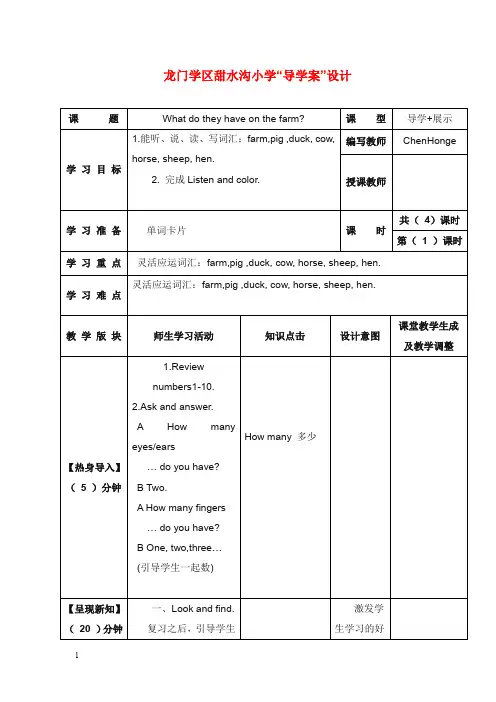
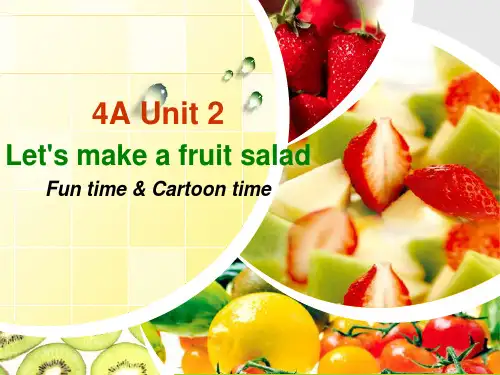
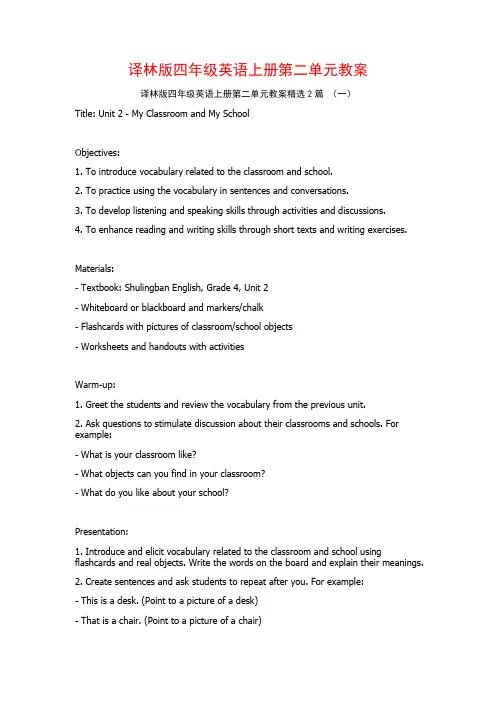
译林版四年级英语上册第二单元教案译林版四年级英语上册第二单元教案精选2篇(一)Title: Unit 2 - My Classroom and My SchoolObjectives:1. To introduce vocabulary related to the classroom and school.2. To practice using the vocabulary in sentences and conversations.3. To develop listening and speaking skills through activities and discussions.4. To enhance reading and writing skills through short texts and writing exercises.Materials:- Textbook: Shulingban English, Grade 4, Unit 2- Whiteboard or blackboard and markers/chalk- Flashcards with pictures of classroom/school objects- Worksheets and handouts with activitiesWarm-up:1. Greet the students and review the vocabulary from the previous unit.2. Ask questions to stimulate discussion about their classrooms and schools. For example:- What is your classroom like?- What objects can you find in your classroom?- What do you like about your school?Presentation:1. Introduce and elicit vocabulary related to the classroom and school using flashcards and real objects. Write the words on the board and explain their meanings.2. Create sentences and ask students to repeat after you. For example:- This is a desk. (Point to a picture of a desk)- That is a chair. (Point to a picture of a chair)Practice:1. Divide the class into pairs or small groups.2. Give each group a set of flashcards or pictures of classroom/school objects.3. Ask each group to arrange the flashcards in different ways, such as by category(e.g., furniture, stationery) or by size (e.g., big, small).4. In rotations, have groups present their arrangements and describe them using the target vocabulary. Encourage students to use complete sentences.5. Monitor and provide guidance as needed.Listening:1. Play a recording of a short conversation about a classroom or school.2. Ask students to listen and answer questions related to the conversation.3. Play the recording again if necessary.4. Discuss the answers as a class.Reading:1. Provide short texts about a classroom or school.2. Ask students to read the texts individually or in pairs.3. Have a class discussion about the texts, focusing on comprehension and key details.4. Ask comprehension questions to check understanding.Writing:1. Provide worksheets with exercises to practice writing sentences using the target vocabulary.2. Have students complete the exercises individually or in pairs.3. Review and discuss the answers as a class.Homework:1. Assign writing tasks where students describe their classrooms or schools using the target vocabulary.2. Encourage students to use complete sentences and include as many details as possible.Assessment:1. Observe and assess students' participation and comprehension during class discussions and activities.2. Review completed worksheets and writing assignments for accuracy and understanding.Notes:- Adapt the lesson plan according to the needs and abilities of the students.- Include additional activities and games to make the lesson more interactive and engaging.- Provide extra support for struggling students and challenge the advanced learners with additional tasks.译林版四年级英语上册第二单元教案精选2篇(二)Unit 1: HelloLesson 1: Greeting and IntroductionsObjectives:- Students will be able to greet and introduce themselves in English.- Students will be able to ask and answer simple questions about personal information.Materials:- Greeting cards with different expressions (e.g. hello, hi, good morning, etc.)- Flashcards of people with names on them- Pictures of different daily activities (e.g. eat, play, sleep, etc.)Procedure:1. Warm-up (5 minutes)- Greet the students with different expressions (e.g. hello, hi, good morning, etc.) and ask them how they are doing.- Ask some students to greet the class using different expressions.2. Introduction (10 minutes)- Show the flashcards of people with names on them. Ask the students to name the people on the flashcards.- Introduce yourself using the flashcards (e.g. Hello, my name is Mark).- Have the students repeat after you and introduce themselves using the flashcards (e.g. Hello, my name is Sarah).3. Vocabulary (15 minutes)- Show the pictures of different daily activities.- Teach and practice the vocabulary words for each activity.- Have the students repeat the words after you and practice using them in sentences (e.g. I eat breakfast in the morning).4. Pair Work (15 minutes)- Divide the class into pairs.- Give each pair a set of greeting cards.- In their pairs, students will take turns choosing a greeting card and using it to greet their partner. They will then introduce themselves and ask and answer questions about their daily activities.5. Group Activity (15 minutes)- Divide the class into larger groups.- Give each group a set of flashcards and pictures of daily activities.- In their groups, students will take turns picking a flashcard and a picture. They will then introduce the person on the flashcard and tell the group what activity they do (e.g. This is Sarah. She eats breakfast in the morning).6. Wrap-up (5 minutes)- Review the vocabulary and expressions learned in the lesson.- Ask students to share one thing they learned about a classmate during the pair and group activities.Assessment:- Observe students' participation and ability to greet and introduce themselves.- Listen for correct pronunciation and usage of vocabulary words.- Monitor students' ability to ask and answer questions about personal information.。
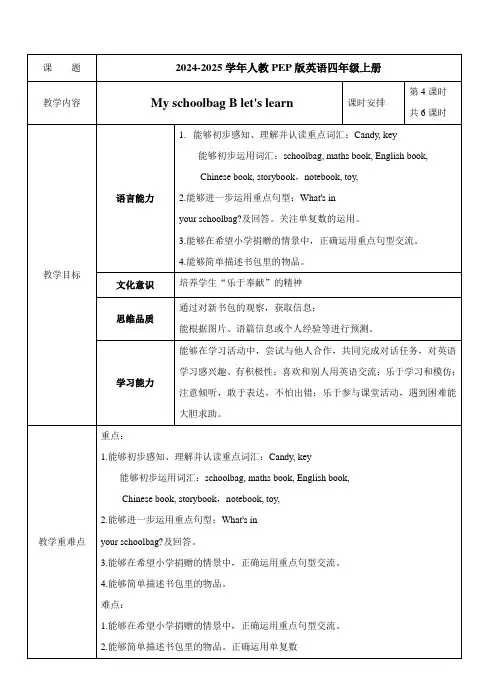
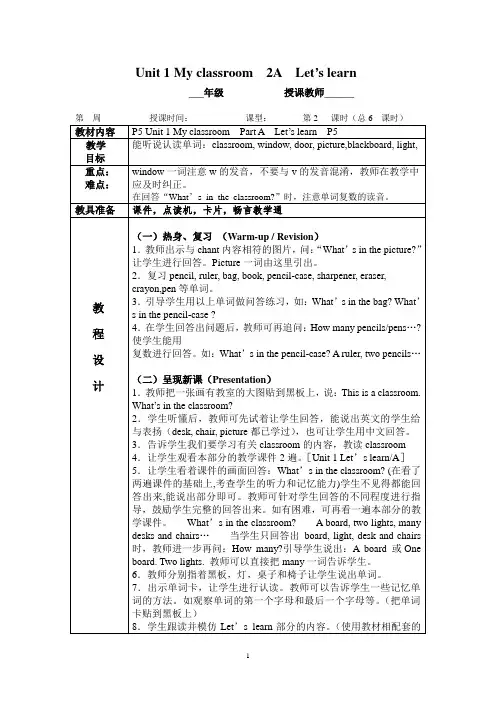
Unit 1 My classroom 2A Let’s learn___年级授课教师______第周授课时间:课型:第2 课时(总6 课时)教材内容P5 Unit 1 My classroom Part A Let’s learn P5教学目标能听说认读单词:classroom, window, door, picture,blackboard, light,重点:难点:window一词注意w的发音,不要与v的发音混淆,教师在教学中应及时纠正。
在回答“What’s in the classroom?”时,注意单词复数的读音。
教具准备课件,点读机,卡片,畅言教学通教程设计(一)热身、复习(Warm-up / Revision)1.教师出示与chant内容相符的图片,问:“What’s in the picture?”让学生进行回答。
Picture一词由这里引出。
2.复习pencil, ruler, bag, book, pencil-case, sharpener, eraser, crayon,pen等单词。
3.引导学生用以上单词做问答练习,如:What’s in the bag? What’s in the pencil-case ?4.在学生回答出问题后,教师可再追问:How many pencils/pens…?使学生能用复数进行回答。
如:What’s in the pencil-case? A ruler, two pencils…(二)呈现新课(Presentation)1.教师把一张画有教室的大图贴到黑板上,说:This is a classroom. What’s in the classroom?2.学生听懂后,教师可先试着让学生回答,能说出英文的学生给与表扬(desk, chair, picture都已学过),也可让学生用中文回答。
3.告诉学生我们要学习有关classroom的内容,教读classroom 4.让学生观看本部分的教学课件2遍。
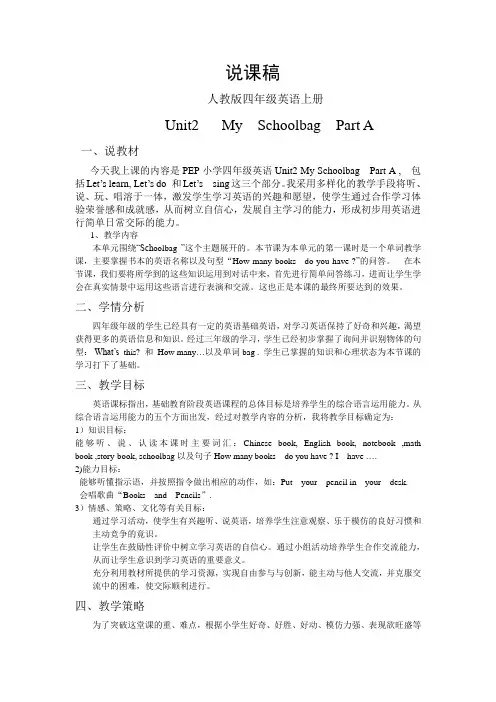
说课稿人教版四年级英语上册Unit2 My Schoolbag Part A一、说教材今天我上课的内容是PEP小学四年级英语Unit2 My Schoolbag Part A , 包括Let’s learn, Let’s do 和Let’s sing这三个部分。
我采用多样化的教学手段将听、说、玩、唱溶于一体,激发学生学习英语的兴趣和愿望,使学生通过合作学习体验荣誉感和成就感,从而树立自信心,发展自主学习的能力,形成初步用英语进行简单日常交际的能力。
1、教学内容本单元围绕“Sch oolbag ”这个主题展开的。
本节课为本单元的第一课时是一个单词教学课,主要掌握书本的英语名称以及句型“How many books do you have ?”的问答。
在本节课,我们要将所学到的这些知识运用到对话中来,首先进行简单问答练习,进而让学生学会在真实情景中运用这些语言进行表演和交流。
这也正是本课的最终所要达到的效果。
二、学情分析四年级年级的学生已经具有一定的英语基础英语,对学习英语保持了好奇和兴趣,渴望获得更多的英语信息和知识。
经过三年级的学习,学生已经初步掌握了询问并识别物体的句型:What’s this? 和How many…以及单词bag . 学生已掌握的知识和心理状态为本节课的学习打下了基础。
三、教学目标英语课标指出,基础教育阶段英语课程的总体目标是培养学生的综合语言运用能力。
从综合语言运用能力的五个方面出发,经过对教学内容的分析,我将教学目标确定为:1)知识目标:能够听、说、认读本课时主要词汇:Chinese book, English book, notebook ,math book ,story-book, schoolbag以及句子How many books do you have ? I have ….2)能力目标:能够听懂指示语,并按照指令做出相应的动作,如:Put your pencil in your desk.会唱歌曲“Books and Pencils”.3)情感、策略、文化等有关目标:通过学习活动,使学生有兴趣听、说英语,培养学生注意观察、乐于模仿的良好习惯和主动竞争的竟识。
教学内容:M4U2 I was very nervous.教学目的:群力小学张茗1、知识与能力目标:(1)词汇:nervous, end, proud,(2)语句:I was very nervous.In the end everyone clapped.And I was very proud.2、情感态度目标:学生能够运用所学的英语主动练习和实践,让学生通过本课的学习,能够初步产生对于音乐欣赏的兴趣,培养他们欣赏音乐美的能力。
教学重难点:1、学会学习描述过去做的事。
2、能够掌握重点词、句。
3、会总结归纳规则、不规则的动词过去式。
4、进行语篇的训练,描述自己过去做的事情。
教学过程:Step1. Warm-up1.Sing a song :2.Listen to the sound and guess what it is (instruments) ? Then look at the pictures and answer the questions.Piano , violin , pipa , flute , guitar , drum, erhu .Q: What did she play ? What did they play ? What did I play ?Step2.Leading- in1.I like music very much . Here is a photo of me . Do you want to know aboutme ? (课件呈现四个疑问词what , when , where , how )Please guess : What did I play ? When did I play ?Where did I go ? How did I feel ?(在学生的回答过程中,答对后出现照片的一部分,教师给予奖励。
)2.回答问题:I was very nervous .时,教师讲授新词nervous 并图片拓展表示感受的形容词让学生说一说:She was happy .happy , sad , tired, bored, excited, worried, angry , surprised,scared.Step3. Presentation1.图片Amy 紧张的图片。
Recycle 2 第2课时浙江公开课教案1. Meet SantaT: What happened then? Let’s wait.Santa comes with reindeer, sleigh and Elf.2. Mike’s homeSanta: Hohoho, where is the little boy’s room?T: (Point and ask) Is this Mike’s bedroom?T asks students to come to the front, point and ask their friends, find Mike’s bedroom at last.3. Mike’s bedroom(1) T: Mike’s bedroom is sonice. But where are these things? Let’s ask your partner and find the answers.(2) Listen and answerWhere is the gift?T: Can you see the gift under the window? Ha, look, it’s in the sock.(3) Listen again and find out the route.(4) Read after Santa and Elf. 4. Sarah’s home(1) Listen to Santa and Elf, then answer:Where are Santa and Elf? (2) Let’s act as Santa and Elf. Santa: Ouch! Where are we now?Elf: Oh, it’s a cat. It’s near thefridge.Santa: Oh, it’s a kitchen. Let’s move.3) Choose one room and makea new dialogue with your desk mate.5. On the way home(1) Santa: (goes to different homes) I’m so busy. I’m tired. I want to go home.(2) On the way home, Santa meets a little girl.Look at the pictures and guess: What will the girl say?(3) Listen and fill in the blank. Can I use your sleigh, Santa? My bus is late and my bike is at home.(4) What will Santa say to the girl?A. Yes, of course.B. Sorry, I’m so tired.(5) Listen and find the answer. Yes, little girl. Give them some cake and they can take you home.Thank you so much. What do you want, Santa?Just give me a smile. It’s free to be nice.(6) What do you think of Santa? He is ____.How about the girl?She is ____.1. Santa’s home(1) Santa is so tired. Look! He is sleeping now.T: Santa is so nice. What can2. Homework(1) Imitate the dialogue on your worksheet.(2) Prepare a “free” Christmas gift for your friends and family.。
英语〔四年级上册〕Unit 2 Let’s make a fruit saladStory timeTeaching aims and learning objectives 教学目标1. 学生能够运用句型“Do you have … 〞进行提问并答复;2. 学生能够理解故事内容;3. 学生能够朗读并表演故事。
Focus of the lesson and predicted area of difficulty 教学重点和难点教学重点:1. 学生能够从整体上阅读故事并理解;2. 学生能够用正确的语音、语调朗读对话,表演故事。
教学难点:学生能够阅读理解故事并表演。
Teaching procedures 教学过程Step 1 Greeting1. Song time: Apple round, apple redT: Hello, boys and girls.S: Hello, Sunny.T: Nice to meet you.S: Nice to meet you, too.T: Now, let’s enjoy a song. Look! (PPT播放歌曲)What fruit do you hearSs: Apples.T: Do you like applesS1: Yes, I do. / No, I don’t.T: What about you Do you like applesS2: Yes, I do./ No, I don’t.2. Game time: Magic eyesT: I like apples, and I like many kinds of fruits. Do you like fruitS: Yes.T: Let’s play a game with fruit. Please stand up and shout the name of the fruit as loudly and quickly as you can. UnderstandS: Yes.T: Ready Go!S: An orange/ A pear/ An apple/…Step 2 Presentation1. T: Wow, you can name many kinds of fruit. And you have some fruit on your desks,right What do you have Do you have a bananaS1: No, I don’t.T: Do you have any bananasS2: Yes, I do.T: Can I have oneS2: Sure, here you are.T: Thank you.T: Please follow me “Do you have … 〞If you have, you can say〞Yes, I do. 〞If you don't have, you can say〞No, I don’t. 〞(板书相关句型。
四年级上册英语教案人教版四年级上册英语教案人教版通用5篇“教师”就应是个具有超卓的德行持重明达和善的人,每一个教师都应该懂得写一篇教案。
下面是我为你准备的四年级上册英语教案人教版,快来借鉴一下并自己写一篇与我们分享吧!四年级上册英语教案人教版篇2课型:新授课课时:1 课时教材:人教版四年级上册Unit 4 My Home Let’s learn教学目标:1.知识目标:借助图片、课文,能准确认读单词或短语bedroom,study,living room,kitchen,bathroom。
能熟练运用特殊疑问句Where is...?和一般疑问句Is she/he in the...? 对人物的位置进行提问。
2.能力目标:能用所学的句型和单词对人物的方位进行提问和回答。
能认识家里各个房间的名称和功能,并能够说出和表演出能在相应房间中做的活动,如watch TV,read a book,havea snack,have a nap,take a shower 等。
3.情感态度与价值观目标:能够理解家的重要性和意义,并能够培养良好的生活和家庭习惯。
能体会到英语学习的乐趣,并能与教师、同学积极交流。
教学重点:精通并准确运用本课单词或短句以及句型描述人物方位。
教学难点:理解良好生活习惯的重要性。
教学工具:教材,音频,多媒体课件。
教学过程:Step1:Lead-inGuessing Game:课前,教师和同学们做一个小游戏。
教师来表演动作,学生一起猜。
教师分别表演动作watch TV,read a book,have a snack,have a nap,take a shower,学生用英文答出相应的动作。
教师注意嘉奖答得又快又准确的同学。
游戏过后,教师提问学生可以在哪里做这些活动呢?“Where can we watch TV/ read a book/ have a snack...? ”由此引出My Home 的主题。
课程名称:新视野大学英语第四册单元主题:Secrets to Beauty(美丽秘诀)教学目标:1. 语言技能:- 学生能够运用英语讨论人们对美的追求。
- 学生能够进一步理解文本内容。
- 学生能够应用短语和句型。
- 学生能够掌握议论文的写作技巧。
2. 文化理解:- 学生能够了解不同文化中美的观念。
- 学生能够探讨美与审美标准之间的关系。
3. 批判性思维:- 学生能够对美的追求进行批判性思考。
- 学生能够提出自己的观点并支持论点。
教学时间:8课时教学过程:第一课时:Part I Warming Up1. 导入:- 通过图片或视频展示不同文化中美的标准,引发学生讨论。
- 提问:你认为什么是真正的美?为什么?2. 热身活动:- 学生分享自己对美的理解,以及他们追求美的经历。
3. 阅读前准备:- 预测课文内容,通过观看相关视频或阅读摘要来了解背景信息。
第二课时:Part I Warming Up(续)1. 观看视频:- 播放关于美的追求的视频,如时尚杂志、广告等。
2. 讨论:- 学生讨论视频中的美的标准,以及这些标准对他们的影响。
3. 阅读前预测:- 学生根据视频内容预测课文可能讨论的主题。
第三课时:Part II Text Study1. 阅读深度:- 学生阅读课文,分析文章结构、总结主要内容、分析难句。
2. 语言点:- 讲解课文中的重点短语和句型,如:“pursuit of beauty”、“make-up”等。
3. 练习:- 学生练习使用课文中的短语和句型进行口语和写作练习。
第四课时:Part II Text Study(续)1. 文本分析:- 学生分析作者的观点,并讨论作者如何支持这些观点。
2. 文化背景:- 探讨不同文化中美的观念,以及这些观念如何影响人们的行为。
3. 批判性思考:- 学生讨论课文中的观点,并提出自己的看法。
第五课时:Part III Essay Writing1. 写作指导:- 讲解议论文的写作结构,如引言、论点、论据、结论等。